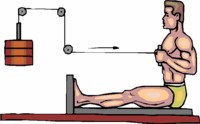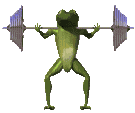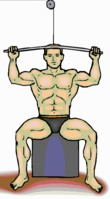The
8 Basic Resistance Training Movements
by Phil Kaplan
 It's
amazing how exercise equipment manufacturers have managed
to reinvent the same machines over and over again. If you
could use your imagination, and while envisioning a favorite
exercise machine in motion remove the machine and actually
view the movement of the bodyparts involved, you'd see that
most of the most popular exercises can be reduced to 6 primary
movements. It's
amazing how exercise equipment manufacturers have managed
to reinvent the same machines over and over again. If you
could use your imagination, and while envisioning a favorite
exercise machine in motion remove the machine and actually
view the movement of the bodyparts involved, you'd see that
most of the most popular exercises can be reduced to 6 primary
movements.
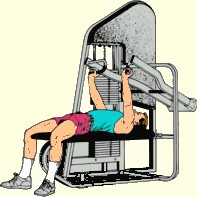 Let's
consider, as an example, a chest press machine. You would
either sit or lie down and you push two fixed handles directly
out in front of you so you finish with your arms extended,
the resistance pressing your hands back toward your chest. Let's
consider, as an example, a chest press machine. You would
either sit or lie down and you push two fixed handles directly
out in front of you so you finish with your arms extended,
the resistance pressing your hands back toward your chest.
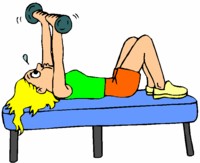 Now
visually remove the machine, have the body lie face up on
a bench, and mentally place on dumbbell in each hand. You
now have a dumbbell bench press. The resistance is being focused
in the same manner, pushing the hands back toward the chest
when the arms are fully extended. Now take that body, remove
the weights, remove the bench, and flip it over so it's lying
on the floor face down. Now
add motion. Now
visually remove the machine, have the body lie face up on
a bench, and mentally place on dumbbell in each hand. You
now have a dumbbell bench press. The resistance is being focused
in the same manner, pushing the hands back toward the chest
when the arms are fully extended. Now take that body, remove
the weights, remove the bench, and flip it over so it's lying
on the floor face down. Now
add motion.
 Yup,
it's the old standard pushup. In health clubs members argue
over which is better, the Hammer Strength Chest Press, the
Bodymasters Chest Press, or the old Nautilus Chest Press,
and the fact is, those dumbbells sitting over on the dumbbell
rack can do very much the same thing as those $3,000 machines.
I get no less than one hundred e-mails per week asking me
"which is better" and naming machines, and another
hundred from people wanting me to design a resistance exercise
routine. My programs, TRANSFORM, The ANSWER, and The Best
You've Ever Been all include very complete strategically designed
programs, but if you're not ready to take that leap, if you
just want the basics, I absolutely guarantee that if you incorporate
this six movements into a regular resistance exercise routine,
challenging the muscles beyond the challenge they're used
to, you're going to notice strength increases, muscle tone,
and the body beginning to feel more solid. You don't NEED
machines. You don't even NEED one of my programs. You just
need a basic understanding of how to challenge muscle, and
then of course you have to balance the resistance exercise
with moderate aerobic exercise and supportive nutrition. Yup,
it's the old standard pushup. In health clubs members argue
over which is better, the Hammer Strength Chest Press, the
Bodymasters Chest Press, or the old Nautilus Chest Press,
and the fact is, those dumbbells sitting over on the dumbbell
rack can do very much the same thing as those $3,000 machines.
I get no less than one hundred e-mails per week asking me
"which is better" and naming machines, and another
hundred from people wanting me to design a resistance exercise
routine. My programs, TRANSFORM, The ANSWER, and The Best
You've Ever Been all include very complete strategically designed
programs, but if you're not ready to take that leap, if you
just want the basics, I absolutely guarantee that if you incorporate
this six movements into a regular resistance exercise routine,
challenging the muscles beyond the challenge they're used
to, you're going to notice strength increases, muscle tone,
and the body beginning to feel more solid. You don't NEED
machines. You don't even NEED one of my programs. You just
need a basic understanding of how to challenge muscle, and
then of course you have to balance the resistance exercise
with moderate aerobic exercise and supportive nutrition.
I'll lay out the eight movements
below, and then I'll suggest how they can be structured into
a routine. The illustrations are simply meant to . . . well
. . . to illustrate. They are not intended to be substitutes
for exercise instruction. If you are unfamiliar with the movements,
it would be in your best interest to either get together with
a qualified fitness professional, or perhaps to join eFitness
and make use of their virtual trainer feature.
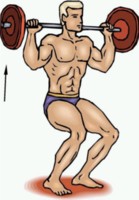 Squat
- whether you're performing a leg press where your body
is in motion and your feet rest against a platform, or you're
performing a leg press where your back is supported and you
use your legs to push the resistance away from you, you are
moving from the hip and knee joints extending the legs. This
calls to action the large frontal thigh muscles named the
quadriceps and the powerful gluteus (otherwise known as .
. . the butt muscle). One of the most all encompassing resistance
training movements is the Squat which has you moving in precisely
the same manner as a leg press machine, but calls into play
balance and stability muscles used in real world movement. Squat
- whether you're performing a leg press where your body
is in motion and your feet rest against a platform, or you're
performing a leg press where your back is supported and you
use your legs to push the resistance away from you, you are
moving from the hip and knee joints extending the legs. This
calls to action the large frontal thigh muscles named the
quadriceps and the powerful gluteus (otherwise known as .
. . the butt muscle). One of the most all encompassing resistance
training movements is the Squat which has you moving in precisely
the same manner as a leg press machine, but calls into play
balance and stability muscles used in real world movement.
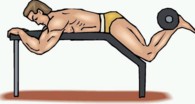 Leg
Curl - the hamstring muscles in the rear of the thigh
contract when the knee joint flexes (bends). Whether you're
using a standing leg curl machine, seated leg curl machine,
or lying leg curl machine, the primary movement is the same.
If you have a partner to spot you you can perform this movement
(carefully) holding a dumbbell between your feet lying face
down on the floor. You can even perform a leg curl by lying
on the floor face up with your feet on a stability ball if
you press your heels downward into the ball as your knees
bend. Leg
Curl - the hamstring muscles in the rear of the thigh
contract when the knee joint flexes (bends). Whether you're
using a standing leg curl machine, seated leg curl machine,
or lying leg curl machine, the primary movement is the same.
If you have a partner to spot you you can perform this movement
(carefully) holding a dumbbell between your feet lying face
down on the floor. You can even perform a leg curl by lying
on the floor face up with your feet on a stability ball if
you press your heels downward into the ball as your knees
bend.
 Calf
Raise - the soleus and gastrocnemius are more commonly
known as the calf muscles, and they are called upon to allow
you to raise up on your toes, or propel yourself forward when
you walk. Whether you are using a standing calf machine, performing
calf raises on the leg press machine, or holding a dumbbell
as you raise up on your toes, you're efficiently targeting
the calf. Calf
Raise - the soleus and gastrocnemius are more commonly
known as the calf muscles, and they are called upon to allow
you to raise up on your toes, or propel yourself forward when
you walk. Whether you are using a standing calf machine, performing
calf raises on the leg press machine, or holding a dumbbell
as you raise up on your toes, you're efficiently targeting
the calf.
 Row
- There are seated rows, cable rows, bent over barbell rows,
and row row row your boats, but although they may have different
names, they all ask the biceps and upper back muscles to work
together to pull toward the body against resistance. Incorporate
a one-arm row with a dumbbell in your routine and you're calling
to action those very same muscles. Of course, you'll be sure
to work both sides by performing the movement with one arm
and then switching the dumbbell to the other. Row
- There are seated rows, cable rows, bent over barbell rows,
and row row row your boats, but although they may have different
names, they all ask the biceps and upper back muscles to work
together to pull toward the body against resistance. Incorporate
a one-arm row with a dumbbell in your routine and you're calling
to action those very same muscles. Of course, you'll be sure
to work both sides by performing the movement with one arm
and then switching the dumbbell to the other.
Chest Press - we've already
covered this one. You very simply perform a movement that
pushes the resistance away from your body. Dumbbells? Barbells?
It's your preference. You can even use elastic tubing attached
to a sturdy object behind you to push the ends forward in
front of your body. Remember, think not of the machine, but
of the anatomical movement.
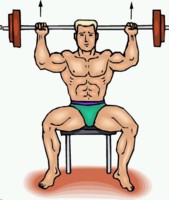 Overhead
Press - This is a great movement for developing, toning,
and strengthening the shoulders. Whether you're pushing the
handles of the Cybex shoulder press machine, performing a
seated dumbbell shoulder press, an overhead barbell press,
or standing on your head and pushing your body away from the
floor (don't try this one at home), the movement is the same. Overhead
Press - This is a great movement for developing, toning,
and strengthening the shoulders. Whether you're pushing the
handles of the Cybex shoulder press machine, performing a
seated dumbbell shoulder press, an overhead barbell press,
or standing on your head and pushing your body away from the
floor (don't try this one at home), the movement is the same.
 Biceps
Curl - To work the biceps, you bend the elbow against
resistance. There are all sorts of machines, cable units,
and hydraulic devices to work the biceps, but a dumbbell in
hand can stimulate development quite efficiently. Biceps
Curl - To work the biceps, you bend the elbow against
resistance. There are all sorts of machines, cable units,
and hydraulic devices to work the biceps, but a dumbbell in
hand can stimulate development quite efficiently.
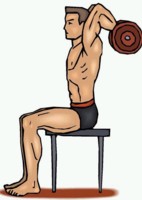 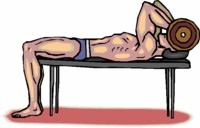 Tricep
Extension - While the biceps bend the elbow, the triceps
extend the arm from the elbow joint. They are being called
to act in the chest press and shoulder press movements, but
if you want to work that "back of the arm" area,
incorporate a movement that begins with the elbow bent, and
then pushes, against resistance, to extend (straighten) the
arm. This can be done with a dumbbell in each hand lying on
the floor, with a single dumbbell or a barbell overhead, with
one arm at a time in a rear tricep extension, or pushing downward
on a high pulley cable machine. Tricep
Extension - While the biceps bend the elbow, the triceps
extend the arm from the elbow joint. They are being called
to act in the chest press and shoulder press movements, but
if you want to work that "back of the arm" area,
incorporate a movement that begins with the elbow bent, and
then pushes, against resistance, to extend (straighten) the
arm. This can be done with a dumbbell in each hand lying on
the floor, with a single dumbbell or a barbell overhead, with
one arm at a time in a rear tricep extension, or pushing downward
on a high pulley cable machine.
Now, how do you
put these together to form a routine? Here's the most basic
method:
All of the following
routines are based on a three non-consecutive days per week
workout schedule (i.e. Monday, Wednesday, Friday).
Beginner - perform one
set of each movement selecting a weight that will allow
you to get between 15 and 20 repetitions.
Intermediate - perform
three sets of each movement beginning with a light weight
for 15 repetitions, and then gradually increasing for sets
of 8-12 reps.
Advanced - while you might
think advanced exercisers are way beyond the simplicity
of the 8 basic movements, the reality is, most of them are
performing the movements anyway. The stronger the individual,
of course the greater the resistance should be which makes
for a self-adjusting program that modifies itself to meet
invidividual requirements for unique physical challenge.
Will this routine
work forever?
Nope, not if you want ongoing improvement,
but for experienced exercisers who've hit a plateau, it's
a good way to bring things back to the basics, and for beginners
it's a great way to start out.
For those who want something more
advanced, consider the following using my 1-2-3 method of
developing endurance, strength, and power:
You'll use variations of the 8
Basics and over the 6-week period you'll add in the following
additional movements:
Seated Row
|
|
|
|
|
Seated
Row
|
Barbell
Squat
|
Lat
Pulldown
|
The 6-week routine
would look something like this:
Phase I: Endurance - 2 Weeks
|
|
|
Exercise
|
Sets
|
Repetitions
|
Dumbbell Squats
|
Warm
Up Set
|
15 -
25 reps
|
|
2 Sets
|
12-15 reps
|
|
|
|
Seated Chest Press (machine)
|
Warm
Up Set
|
15 -
25 reps
|
|
2 Sets
|
12-15 reps
|
|
|
|
Front Pulldowns
|
Warm
Up Set
|
15 -
25 reps
|
| |
2 Sets
|
12-15 reps
|
|
|
|
|
|
|
Phase II: Strength - 2 Weeks
|
|
|
Leg Press
|
Warm
Up Set
|
12 -
15 reps
|
|
2 Sets
|
6-8 reps
|
|
|
|
Dumbbell Bench Press
|
Warm
Up Set
|
12 -
15 reps
|
|
2 Sets
|
6-8 reps
|
|
|
|
Seated Row
|
Warm Up
Set
|
12 - 15
reps
|
| |
2 Sets
|
6-8 reps
|
| |
|
|
|
|
|
Phase III: Power - 2 Weeks
|
|
|
Barbell Squats
|
Warm
Up Set
|
12 -
15 reps
|
|
2 Sets
|
8-10 reps
|
|
|
|
Barbell Bench Press
|
Warm
Up Set
|
12 -
15 reps
|
|
2 Sets
|
8-10 reps
|
|
|
|
Bent Over Row (barbell)
|
Warm
Up Set
|
12 -
15 reps
|
| |
2 Sets
|
8-10 reps
|
|
|
|
I know many of you have a million
questions, but c'mon now. This article was about the basic
movements. My TRANSFORM! book is 368 pages, the Best You've
Ever Been closer to 400! It just isn't possible to provide
everything in a single article (although I defy you
to find a website with more honest, usable, real world fitness
information than this one).
How do you incorporate abs? Well,
that's an article in itself.
How do you tie this in with aerobic exercise? Another entire
topic to be taken on at a later date. For now, the goal was
to get beginners started and to re-introduce experienced exercisers'
eyes, eyes that might have been clouded by the wild array
of exercise machines, to the simplicity of resistance exercise.
I hope I've done my job. Of course, you can find a great deal
of information on related topics by returning to the Site
Menu or by visiting the pages suggested below. And
of course . . . you can always consider one of my programs!!!!
Suggested
Pages:
Listen
to the audio track
sharing
the information you need to take control of your body!
Then find out the specifics of Supportive
Eating.
Other
Pages To Explore:
[ Fitness
Superstore ]
[ Site Menu ] [ Best
You've Ever Been Audio ] [ Programs
]
[ Quick
Weight Loss ]
[
Feedback ]
[ Home
Page ]

e-mail Phil Kaplan
site
designed and operated by
Phil Kaplan
Phil Kaplan's Fitness Associates
3132 Fortune Way, #D-1
Wellington, FL 33414
561 204-2014
Fax 561 204-2184
|


 It's
amazing how exercise equipment manufacturers have managed
to reinvent the same machines over and over again. If you
could use your imagination, and while envisioning a favorite
exercise machine in motion remove the machine and actually
view the movement of the bodyparts involved, you'd see that
most of the most popular exercises can be reduced to 6 primary
movements.
It's
amazing how exercise equipment manufacturers have managed
to reinvent the same machines over and over again. If you
could use your imagination, and while envisioning a favorite
exercise machine in motion remove the machine and actually
view the movement of the bodyparts involved, you'd see that
most of the most popular exercises can be reduced to 6 primary
movements. Let's
consider, as an example, a chest press machine. You would
either sit or lie down and you push two fixed handles directly
out in front of you so you finish with your arms extended,
the resistance pressing your hands back toward your chest.
Let's
consider, as an example, a chest press machine. You would
either sit or lie down and you push two fixed handles directly
out in front of you so you finish with your arms extended,
the resistance pressing your hands back toward your chest.
 Now
visually remove the machine, have the body lie face up on
a bench, and mentally place on dumbbell in each hand. You
now have a dumbbell bench press. The resistance is being focused
in the same manner, pushing the hands back toward the chest
when the arms are fully extended. Now take that body, remove
the weights, remove the bench, and flip it over so it's lying
on the floor face down. Now
add motion.
Now
visually remove the machine, have the body lie face up on
a bench, and mentally place on dumbbell in each hand. You
now have a dumbbell bench press. The resistance is being focused
in the same manner, pushing the hands back toward the chest
when the arms are fully extended. Now take that body, remove
the weights, remove the bench, and flip it over so it's lying
on the floor face down. Now
add motion.  Yup,
it's the old standard pushup. In health clubs members argue
over which is better, the Hammer Strength Chest Press, the
Bodymasters Chest Press, or the old Nautilus Chest Press,
and the fact is, those dumbbells sitting over on the dumbbell
rack can do very much the same thing as those $3,000 machines.
I get no less than one hundred e-mails per week asking me
"which is better" and naming machines, and another
hundred from people wanting me to design a resistance exercise
routine. My programs, TRANSFORM, The ANSWER, and The Best
You've Ever Been all include very complete strategically designed
programs, but if you're not ready to take that leap, if you
just want the basics, I absolutely guarantee that if you incorporate
this six movements into a regular resistance exercise routine,
challenging the muscles beyond the challenge they're used
to, you're going to notice strength increases, muscle tone,
and the body beginning to feel more solid. You don't NEED
machines. You don't even NEED one of my programs. You just
need a basic understanding of how to challenge muscle, and
then of course you have to balance the resistance exercise
with moderate aerobic exercise and supportive nutrition.
Yup,
it's the old standard pushup. In health clubs members argue
over which is better, the Hammer Strength Chest Press, the
Bodymasters Chest Press, or the old Nautilus Chest Press,
and the fact is, those dumbbells sitting over on the dumbbell
rack can do very much the same thing as those $3,000 machines.
I get no less than one hundred e-mails per week asking me
"which is better" and naming machines, and another
hundred from people wanting me to design a resistance exercise
routine. My programs, TRANSFORM, The ANSWER, and The Best
You've Ever Been all include very complete strategically designed
programs, but if you're not ready to take that leap, if you
just want the basics, I absolutely guarantee that if you incorporate
this six movements into a regular resistance exercise routine,
challenging the muscles beyond the challenge they're used
to, you're going to notice strength increases, muscle tone,
and the body beginning to feel more solid. You don't NEED
machines. You don't even NEED one of my programs. You just
need a basic understanding of how to challenge muscle, and
then of course you have to balance the resistance exercise
with moderate aerobic exercise and supportive nutrition. Squat
- whether you're performing a leg press where your body
is in motion and your feet rest against a platform, or you're
performing a leg press where your back is supported and you
use your legs to push the resistance away from you, you are
moving from the hip and knee joints extending the legs. This
calls to action the large frontal thigh muscles named the
quadriceps and the powerful gluteus (otherwise known as .
. . the butt muscle). One of the most all encompassing resistance
training movements is the Squat which has you moving in precisely
the same manner as a leg press machine, but calls into play
balance and stability muscles used in real world movement.
Squat
- whether you're performing a leg press where your body
is in motion and your feet rest against a platform, or you're
performing a leg press where your back is supported and you
use your legs to push the resistance away from you, you are
moving from the hip and knee joints extending the legs. This
calls to action the large frontal thigh muscles named the
quadriceps and the powerful gluteus (otherwise known as .
. . the butt muscle). One of the most all encompassing resistance
training movements is the Squat which has you moving in precisely
the same manner as a leg press machine, but calls into play
balance and stability muscles used in real world movement.
 Leg
Curl - the hamstring muscles in the rear of the thigh
contract when the knee joint flexes (bends). Whether you're
using a standing leg curl machine, seated leg curl machine,
or lying leg curl machine, the primary movement is the same.
If you have a partner to spot you you can perform this movement
(carefully) holding a dumbbell between your feet lying face
down on the floor. You can even perform a leg curl by lying
on the floor face up with your feet on a stability ball if
you press your heels downward into the ball as your knees
bend.
Leg
Curl - the hamstring muscles in the rear of the thigh
contract when the knee joint flexes (bends). Whether you're
using a standing leg curl machine, seated leg curl machine,
or lying leg curl machine, the primary movement is the same.
If you have a partner to spot you you can perform this movement
(carefully) holding a dumbbell between your feet lying face
down on the floor. You can even perform a leg curl by lying
on the floor face up with your feet on a stability ball if
you press your heels downward into the ball as your knees
bend.  Row
- There are seated rows, cable rows, bent over barbell rows,
and row row row your boats, but although they may have different
names, they all ask the biceps and upper back muscles to work
together to pull toward the body against resistance. Incorporate
a one-arm row with a dumbbell in your routine and you're calling
to action those very same muscles. Of course, you'll be sure
to work both sides by performing the movement with one arm
and then switching the dumbbell to the other.
Row
- There are seated rows, cable rows, bent over barbell rows,
and row row row your boats, but although they may have different
names, they all ask the biceps and upper back muscles to work
together to pull toward the body against resistance. Incorporate
a one-arm row with a dumbbell in your routine and you're calling
to action those very same muscles. Of course, you'll be sure
to work both sides by performing the movement with one arm
and then switching the dumbbell to the other. Overhead
Press - This is a great movement for developing, toning,
and strengthening the shoulders. Whether you're pushing the
handles of the Cybex shoulder press machine, performing a
seated dumbbell shoulder press, an overhead barbell press,
or standing on your head and pushing your body away from the
floor (don't try this one at home), the movement is the same.
Overhead
Press - This is a great movement for developing, toning,
and strengthening the shoulders. Whether you're pushing the
handles of the Cybex shoulder press machine, performing a
seated dumbbell shoulder press, an overhead barbell press,
or standing on your head and pushing your body away from the
floor (don't try this one at home), the movement is the same. Biceps
Curl - To work the biceps, you bend the elbow against
resistance. There are all sorts of machines, cable units,
and hydraulic devices to work the biceps, but a dumbbell in
hand can stimulate development quite efficiently.
Biceps
Curl - To work the biceps, you bend the elbow against
resistance. There are all sorts of machines, cable units,
and hydraulic devices to work the biceps, but a dumbbell in
hand can stimulate development quite efficiently. 
 Tricep
Extension - While the biceps bend the elbow, the triceps
extend the arm from the elbow joint. They are being called
to act in the chest press and shoulder press movements, but
if you want to work that "back of the arm" area,
incorporate a movement that begins with the elbow bent, and
then pushes, against resistance, to extend (straighten) the
arm. This can be done with a dumbbell in each hand lying on
the floor, with a single dumbbell or a barbell overhead, with
one arm at a time in a rear tricep extension, or pushing downward
on a high pulley cable machine.
Tricep
Extension - While the biceps bend the elbow, the triceps
extend the arm from the elbow joint. They are being called
to act in the chest press and shoulder press movements, but
if you want to work that "back of the arm" area,
incorporate a movement that begins with the elbow bent, and
then pushes, against resistance, to extend (straighten) the
arm. This can be done with a dumbbell in each hand lying on
the floor, with a single dumbbell or a barbell overhead, with
one arm at a time in a rear tricep extension, or pushing downward
on a high pulley cable machine.